When this family woke up early in the morning, they saw a little stray dog lying on the stairs in front of their house.
She was exhausted and hungry. Her once-white fur had already turned grey from how dirty she was.
Once she looked at them, her eyes were filled with tears, begging them for help…
Looking For Help
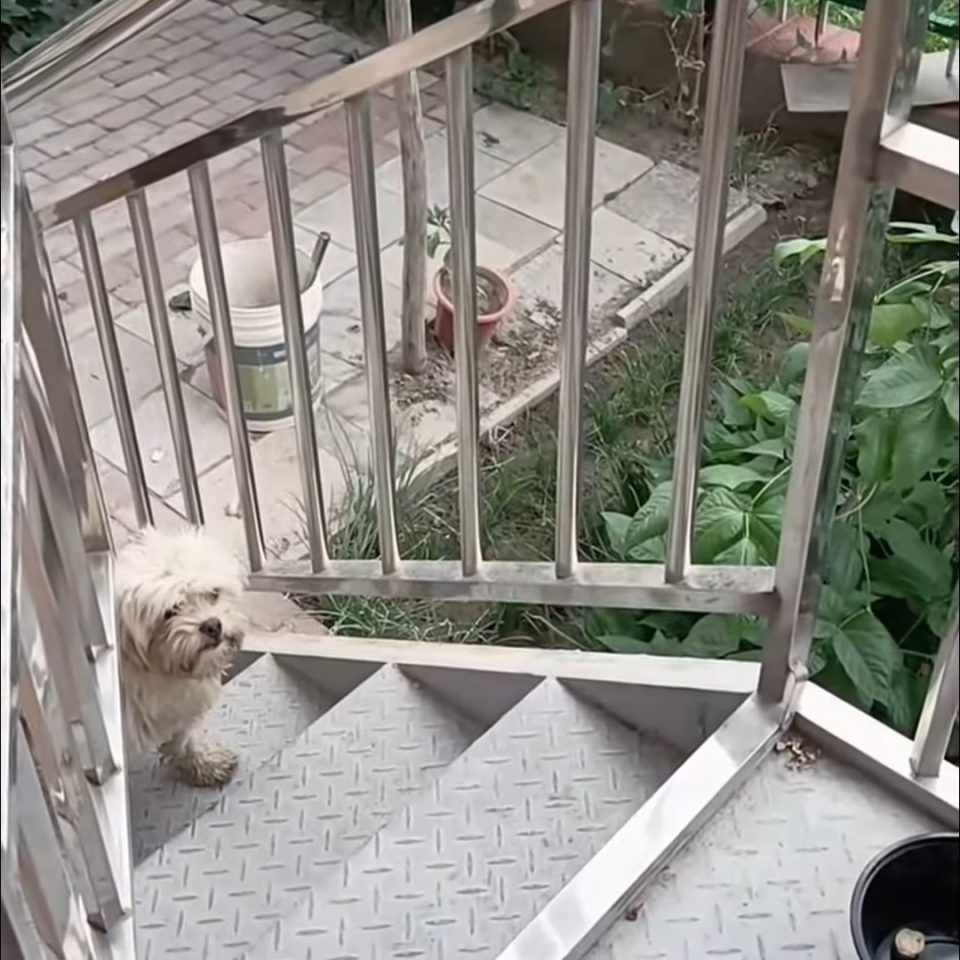
Knowing that she was hungry, the family went to get some food for her. The poor dog was quite wary and scared, but after seeing the food, she stood up, eager to eat.
Who knows how long she hadn’t eaten before she came to this family for help.
However, she was still scared of the family and would not approach the bowl of food until they went inside the house and left her alone with the food.
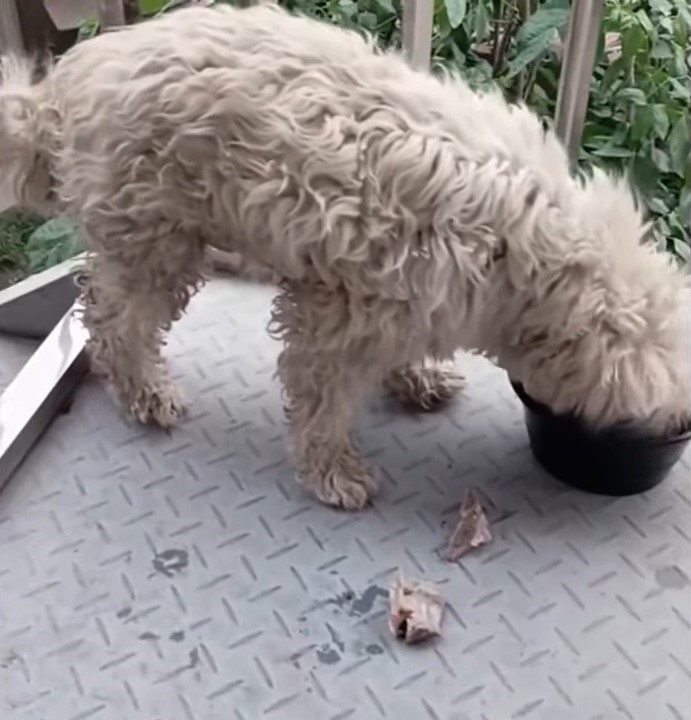
Once they did that, she started eating pretty quickly, trying to fill her empty stomach. She ate all her food and drank some milk.
She seemed to slowly accept the family and their presence. After eating, she stayed on the porch for a bit while she rested, but before they could do anything, she was gone.
Around 8 p.m., she showed up again on the porch looking for more food; however, this time, she wasn’t scared of the people at all. All her timidity was gone.
But, after eating the food that the family gave her, the stray dog once again disappeared. They began to suspect that she was taking care of someone, possibly her children, and that was why she was disappearing all the time.
Adamant to help her, the next morning, the family started preparing a place for her to stay.
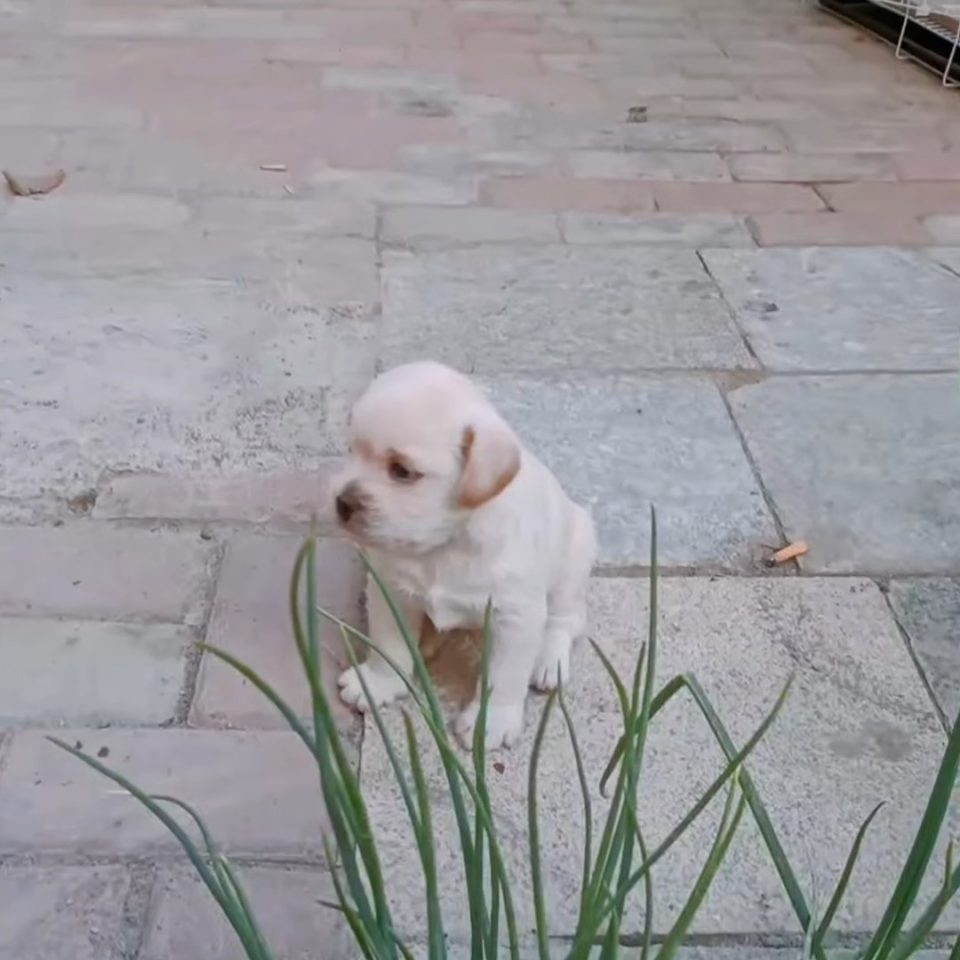
While preparing the carrier, they suddenly heard a faint cry coming from their barn, where they stored their dry firewood.
Curious, they went to investigate, and to their surprise, they found a little white baby that the mama had probably hidden there.
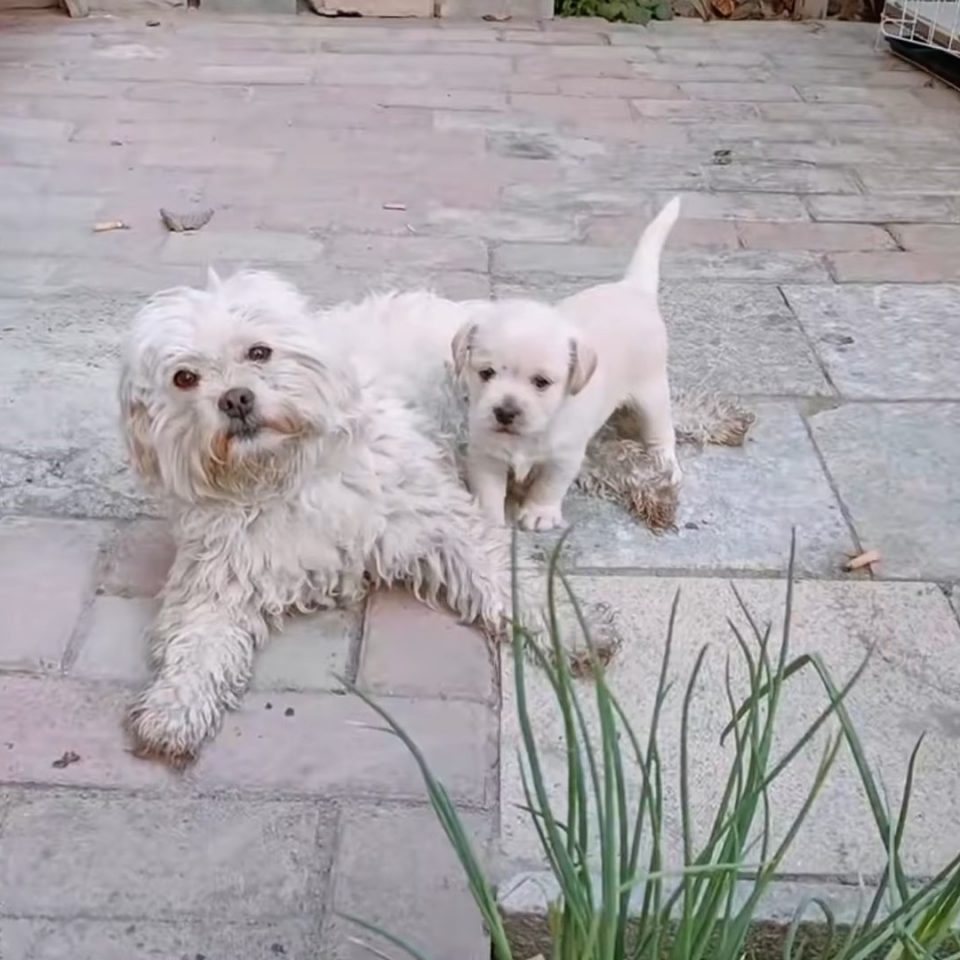

It all made sense now; she was disappearing to take care of her baby.
A Furry Surprise



The family took the little baby and the mama and brought them inside the house. This time, the mama was very happy to cooperate.
Once inside the house, the little family received all the food and care from their now-loving family.
The baby was around two weeks old, but his eyes were fully opened, and he was ready to explore.
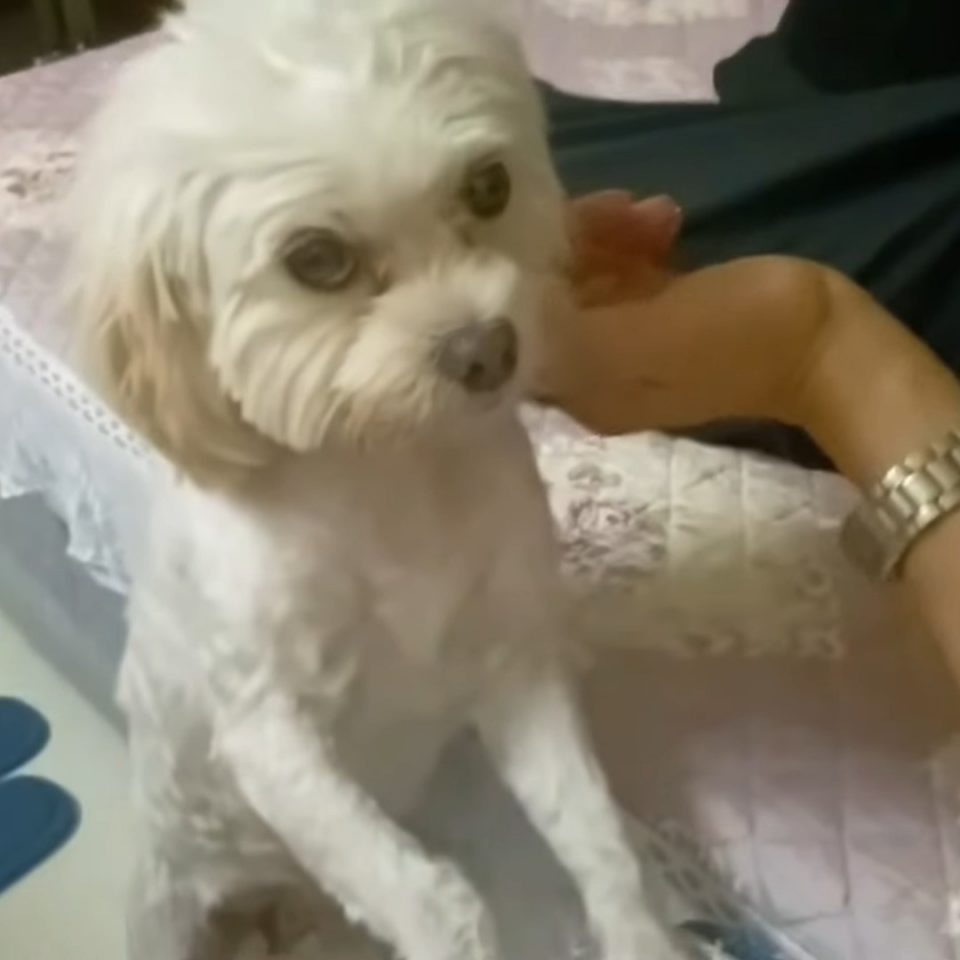

Despite her hard life, the mama dog was always taking good care of her baby, and he was completely healthy and developing normally.
Just one week later, both the mama and the baby had reached their optimal weight and were not malnourished anymore.
Seeing her child happy and growing healthy made the mama much happier. She was always so thankful to the family that rescued her.
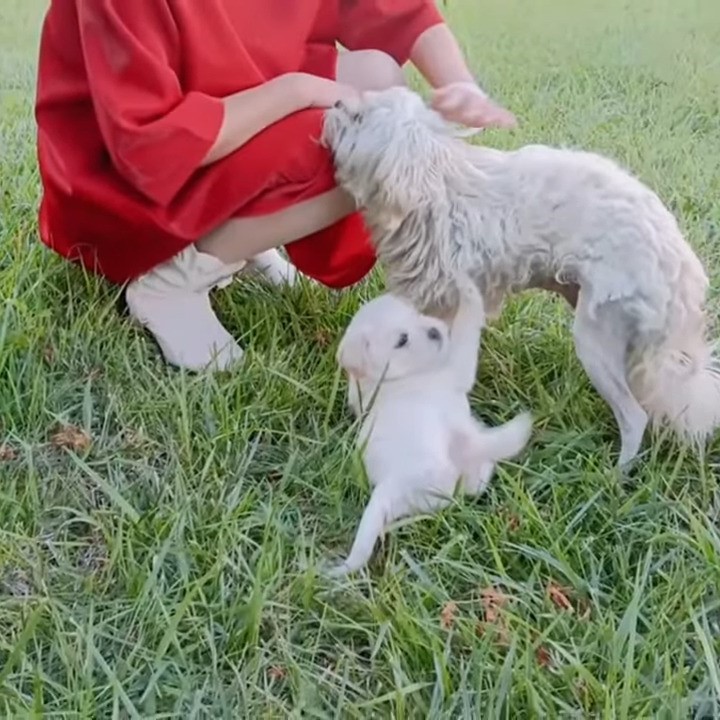

They were eventually adopted by the family, who was happy to have two furry angels that brought so much joy and happiness into their life.
They now enjoy going to parks and on walks on weekends or whenever they’re free. After a visit to the groomer’s, the mama dog was looking completely different, clean, and beautiful.
Their lives changed forever, and they will never have to worry about safety or food again. It’s truly beautiful to know.
Ever noticed how your furry friend gently places their paw on your arm or leg? It’s a common behavior among our canine companions that often leaves us wondering about its meaning. As a seasoned dog trainer, you’ve likely encountered this gesture countless times during your interactions with dogs of all breeds and sizes. It’s a subtle yet powerful way for them to communicate with you, a form of canine language that speaks volumes without a single bark.
When a dog rests their paw on you, it’s more than just a simple touch – it’s a window into their emotions and intentions. Understanding why dogs engage in this behavior can provide valuable insights into their feelings and strengthen the bond between you and your loyal companion. So, the next time your pup reaches out with a gentle paw, take a moment to appreciate the connection they’re trying to establish with you.
Understanding Canine Behavior
The Significance of Body Language in Dogs
Understanding your dog’s body language is crucial for interpreting its feelings and intentions. When your dog places its paw on you, it’s a form of non-verbal communication. It can signify affection, seeking attention, or even a desire for comfort. Paying attention to these cues helps strengthen your bond with your furry friend.
Common Misconceptions About Dog Behaviors
It’s essential to address common misconceptions about dog behavior, including pawing. Some may misinterpret this gesture as simply seeking treats or playtime. However, it often indicates emotional needs, such as reassurance or connection. By grasping the true meaning behind your dog’s actions, you can respond appropriately and nurture a deeper understanding between you and your pet.
The Many Reasons Dogs Use Their Paws
Seeking Attention and Affection
When your furry friend places a paw on you, it’s often a gentle plea for your attention and affection. Dogs are social animals and crave interaction with their favorite humans. By touching you with their paw, they’re asking for a moment of your time and some love.
Expressing a Need or Desire
Sometimes, a dog using its paw is a clear indication of a need or desire. It could signal that they want to go outside, are feeling hungry, or are seeking your help for something. Pay attention to the context in which they place their paw on you to better understand what they might be trying to communicate.
Showing Dominance or Submission
In some cases, dogs may use their paws to display dominance or submission. A dog placing its paw on another dog or on a human could be a way of asserting control or showing submissiveness. Understanding the dynamics of your dog’s behavior can help you decipher whether this gesture is about dominance or submission.
Responding to Human Behavior
Dogs are incredibly attuned to human emotions and actions. When a dog places its paw on you in response to your behavior, it could be their way of showing empathy or providing comfort. They may pick up on your mood or physical cues and offer their paw as a sign of support or solidarity.
The Science Behind Pawing
Insights From Animal Behaviorists
Animal behaviorists suggest that dogs use their paws as a form of communication. This behavior is often rooted in their natural instincts from their wild ancestors. Pawing can serve as a way for dogs to seek attention, express affection, or convey their needs to their human companions. By pawing, dogs can engage with their owners and communicate various emotions effectively.
The Role of Pawing in Dog Communication
Pawing plays a crucial role in dog communication within their social structure. Dogs may use their paws to establish dominance or submission among themselves. When interacting with humans, pawing can be a sign of empathy and understanding. It is essential to interpret the context and accompanying body language to understand the message behind the pawing behavior accurately. By recognizing the significance of pawing in dog communication, you can strengthen your bond with your furry friend and enhance mutual understanding.
How to Respond to Your Dog’s Pawing
Interpreting Your Dog’s Specific Cues
When your dog paws at you, pay attention to their overall body language. Look for signs like wagging tail, relaxed posture, and soft eye contact. These indicate friendliness and a desire for interaction. If your dog seems tense, with rigid body language, growling, or showing teeth, it might be best to give them space.
Training and Discipline Related to Pawing
To address excessive pawing behavior, teach your dog an alternative command like “sit” or “down.” Reward calm behavior and ignore or redirect excessive pawing. Consistency in training is key to modifying your dog’s behavior effectively. Avoid punishing or scolding your dog for pawing, as it may confuse them.
Reinforcing Positive Behaviors
When your dog paws at you gently or sits politely, reward them with treats, praise, or playtime. Positive reinforcement encourages desirable behaviors and strengthens your bond with your furry friend. Remember to be patient and consistent in rewarding positive actions to reinforce good manners in your dog.
The Impact of Breed and Individual Personality
When it comes to why dogs put their paw on you, understanding how breed-specific tendencies influence this behavior can shed light on your furry friend’s actions. Different dog breeds may have distinct ways of using their paws to communicate. For example, some breeds, like retrievers, might paw you as a sign of affection or attention-seeking, while terriers may do it to assert dominance or claim territory.
Your dog’s unique personality also plays a significant role in why they put their paw on you. Just like humans, dogs have individual traits that affect their communication style. Some dogs may be more prone to pawing due to their need for interaction, while others might do it out of habit or comfort. By recognizing your dog’s personality, you can better interpret the meaning behind their pawing behavior.
Breed-Specific Tendencies in Using Paws
Different dog breeds have distinct tendencies when it comes to using their paws to communicate with you. For example:
- Retrievers may paw you for attention or affection.
- Terriers might paw to assert dominance or mark their territory.
- Herding breeds could paw as a herding instinct, trying to guide or control movements.
- Working breeds may paw when they are bored or not sufficiently stimulated mentally.
- Toy breeds might paw as a playful gesture or to indicate they want to engage in activities.
Understanding these breed-specific tendencies can provide insights into why your dog puts their paw on you and help you respond appropriately to their needs.
Understanding Your Dog’s Unique Personality
Just like people, dogs have unique personalities that influence their behavior. Consider these factors when interpreting your dog’s pawing:
- Some dogs may be more outgoing and paw you as a way to seek attention.
- Shy or anxious dogs might paw for reassurance or comfort.
- Dogs with a strong prey drive may paw in a more assertive manner.
- Playful dogs may use their paws to signal they want to play or interact with you.
- High-energy dogs may paw when they need physical or mental stimulation.
By understanding your dog’s personality traits, you can better connect with them and strengthen your bond by responding appropriately to their pawing behavior.
Conclusion
Understanding why dogs put their paw on you goes beyond a simple gesture. It’s their way of communicating various needs and emotions. From seeking attention to showing affection, each pawing instance conveys a unique message. Breed-specific tendencies and individual personality traits further shape this behavior, adding depth to the interaction between you and your furry friend. By recognizing the context and cues accompanying pawing, you can strengthen your bond and create a deeper connection with your dog. So, next time your pup places their paw on you, remember, it’s more than just a touch – it’s a form of communication that speaks volumes about your relationship.
Frequently Asked Questions
Why do dogs paw at you?
Dogs paw at you to seek attention, express their needs, show dominance or submission, or play. Understanding the context and body language accompanying pawing is crucial for interpreting their message accurately.
Do different dog breeds have specific reasons for pawing?
Yes, different breeds may paw for attention, affection, dominance, or playfulness based on their tendencies. Understanding breed-specific behaviors can help decipher why a dog puts their paws on you.
How does a dog’s personality affect their pawing behavior?
A dog’s unique personality traits can influence their pawing behavior, whether for interaction, comfort, or stimulation. Recognizing these individual traits helps owners understand and respond to their dog’s pawing better, strengthening the bond between them.
[no_toc]


Hey there, I’m Janet Brooks, a dog-loving student from California. I’m all about helping pups in need, especially those without homes. Me and my awesome friends work together to give shelter and love to stray dogs. Oh, and I also write blogs about dogs to share helpful info.